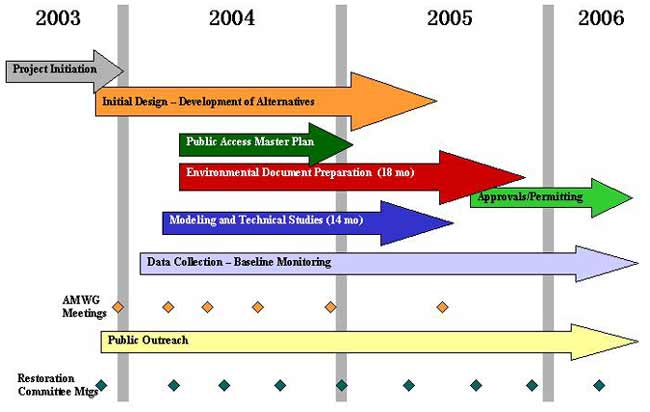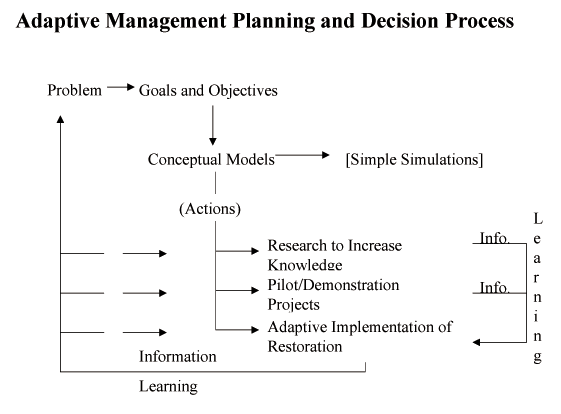|

Project
Goals
- Provide shoreline access, educational and recreational
opportunities.
- Benefit native species by re-establishing natural ecological
processes and habitats.
- Contribute to scientific understanding of ecological restoration
by implementing the project under an adaptive management
framework.
Implementation
Commitments
The project partners realize that restoration must be planned
and implemented carefully to avoid any unintended negative
impacts. The project team is committed to implementing the
project consistent with the following:
- Avoid and/or mitigate degradation of drinking water quality
- Minimize the potential for mercury methylation
- Measure water quality impacts
- Minimize the establishment of nuisance species through
design and management
- Avoid and/or mitigate impacts to existing infrastructure
and easements on and immediately adjacent to the property
[top of page]
Background
For over a hundred years, the Dutch Slough property was used
for grazing and dairy operations. However, during the past
twenty years, eastern Contra Costa County has undergone a
rapid urbanization. Beginning in the 1990s, the former landowners
began securing approvals for the eventual development of the
property. In 1997, Contra Costa County approved a development
agreement for this property that would have allowed for the
construction of 4,500-6,100 housing units on the site. When
the City of Oakley incorporated in 1999, this property was
within the city limits, and the City was required to accept
the County's development agreement.
In the fall of 2001 the Natural Heritage Institute (NHI)
and the Department of Water Resources identified this site
as an important restoration opportunity and began working
cooperatively with the former landowners to obtain grant funding
to acquire and restore the property. During 2002, the project
partners worked with the Oakley City Council to build local
support for the project. In the fall of 2002, Ecosystem Restoration Program and the
State Coastal Conservancy's San Francisco Bay Area Program
awarded grants to fund the acquisition. In the fall of 2003,
the Department of Water Resources completed the purchase of
the 1,166-acre restoration site.
Site
Description
The Dutch Slough site is located in the western Delta, in
the City of Oakley, in eastern Contra Costa County. The site
encompasses 1,166-acres. It is bounded by Dutch Slough on
the north, Marsh Creek on the west, the Contra Costa Canal
on the south and Jersey Island Road on the east. The site
is comprised of three units, partially separated by Emerson
Slough and Little Dutch Slough. Unlike much of the Delta,
the site is not deeply subsided and still has topographic
diversity. Click here
to view maps of the site.
East Bay Regional Park District's Big Break Regional Shoreline
is adjacent to the western edge of the site. The City of Oakley
will own a 55-acre community park at the south end of the
restoration site.
[top of page]
Schedule
Developing the restoration plan, completing a review of the
environmental impacts and obtaining permits is expected to
take longer than 2006.

[top of page]
Adaptive
Management
The Dutch Slough project provides a significant opportunity
to improve understanding of restoration science in the Delta
ecosystem. Adaptive management employs the scientific method
to maximize the information value of restoration and management
actions. With the assistance of a panel of scientists, the
project team will design restoration actions to test hypotheses
about how the ecosystem functions and how best to achieve
the project objectives. In this respect, adaptive management
interventions are conducted as experiments. Project implementation
will be guided by the best available information but will
be monitored and implemented with the goal of increasing our
understanding about the science of restoration.
Adaptive
Management Diagram

To find out more about Adaptive Management,
view two chapters of the California
Bay Delta Authority Ecosystem Restoration Program Plan - Volume
3 - Strategic Plan For Ecosystem Restoration (pdf format).
Adaptive
Management Working Group
The Adaptive Management Working Group (AMWG) is an interdisciplinary
team of nine technical experts that help the project
management team and its consultants identify key science
questions to be addressed within the Dutch Slough project's
goals and objectives. These questions are the foundation
of the active adaptive management plan. The AMWG reviews
and helps refine the project's conceptual model, its hypotheses
and the proposed management actions. The AMWG providse
technical assistance to the project management team to help
develop the adaptive management plan for the restoration,
specifically helping design the implementation approach and
ensuring the implementation and monitoring will result
in statistically valid testing of hypotheses.
AMWG
Members:
Bruce Herbold, Ph.D. US EPA (fish biologist)
Stuart Siegel, Ph.D. Private Consultant (wetland scientist)
Peter Baye, Ph.D. Private Consultant (coastal vegetation
ecologist)
Mark Stacey, Ph.D. UC Berkeley (fluid dynamics)
Roger Fujii, Ph.D. USGS (water quality –dissolved organic
carbon)
Joan Florsheim, Ph.D. UC Davis (geomorphology)
John Takekawa, Ph.D. USGS (ecologist)
David Sedlak , Ph.D. UC Berkeley (mercury methylation processes)
Lars W.J. Anderson, Ph.D. UC Davis (exotic and invasive weeds)
[top of page]
Restoration
Planning
The DWR, Conservancy, and CALFED are working with other project
partners to develop a restoration plan that achieves the goals
and objectives of the project. In addition to the project
team, a Restoration Committee has been established to obtain
input from and provide information to stakeholders and the
public. The Dutch Slough Adaptive Management Working Group
is composed of nine scientists to identify key science questions,
provide technical review and help develop the project's adaptive
management plan. A consultant team, led by Philip Williams
& Associates has also been hired to help develop restoration
alternatives and conduct a feasibility analysis of those alternatives.
View the Dutch
Slough Opportunities and Constraints Presentation (PDF
format) to learn more about the restoration planning process.
Restoration
Committee
The Dutch Slough Restoration Committee is a forum to exchange
information, obtain input into the restoration planning and
keep interested partners informed about other projects and
regional issues that affect the Dutch Slough project. Key
agencies and stakeholders have been invited to attend and
participate on this Committee, and the meetings are open to
the public. For updates on Committee meetings, please click
here.
Current
Restoration Committee Members (updated 10/20/08)
Public
Access Planning
The Conservancy and CALFED awarded grant funds to the
City of Oakley to develop a public access master plan for
the Dutch Slough Restoration Site and the adjacent community
park site. The purpose of the master plan is to develop
an overall vision for public access to the site. A Request
for Proposals was issued in 2004, a consultant (2M Associates) was contracted
with the City in March 2005, and the City Council approved the Dutch
Slough Community Park and Public Access Conceptual Master Plan in August 2006. For information on upcoming meetings,
please click here.
Environmental
Review
The
Department of Water Resources, as the lead agency, released the Dutch Slough Tidal Marsh Restoration Project Draft Environmental Impact Report (Draft EIR) on November 20, 2008. The public has 60 days to comment on the project. Grassetti Environmental Consulting was hired to write the EIR. DWR put out a Notice of Preparation of Draft Environmental Impact Report on March 24, 2006. A formal scoping hearing, designed to solicit public comment on the proposed action and
alternatives, was held on April 5, 2006. For more information and upcoming meetings,
please click here.
Please click here
if you have any questions or comments.
[top of page]
|

